Field Experimental Study on the Infiltration and Clogging Processes at Aksu Research Site, Kazakhstan
Abstract
1. Introduction
2. Main Framework
2.1. Geographical Framework
- -
- Aquifer of alluvial undivided recent and Upper Quaternary deposits (al QIII–IV), represented by sands, sandy loams, sandy gravel–pebble deposits with interlayers of loams, clays, and siltstones, and aquifer thickness that varies from 15 to 35 m. The groundwater level depth varies from 3 to 5 m in the spring and from 5 to 7 m in the summer. The groundwater salinity does not significantly change during the year and is up to 1 g/L TDS, with a predominant bicarbonate sulfate sodium composition. The hydraulic conductivity coefficient is 3.15–4.5 m/day. The water well discharge rate during experimental airlift pumping was 0.6–0.9 L/s with groundwater level drawdown equal to 1.5–2.5 m.
- -
- Aquifer of alluvial-lacustrine Middle Quaternary (QA) deposits, represented by fine and uneven-grained sands, loose, weakly cemented sandstones with interlayers of thin loams and clays. The aquifer thickness increases from 40 m closer to the Aksu riverbed to 100 m in the direction of the Akozek River. The groundwater level depth varies from 3 to 4 m in the spring and from 4 to 7 m in the summer. The groundwater salinity ranges from 1 to 2 g/L in the northern part of the study area to 2 to 2.5 g/L near the Akozek River. Groundwater has the prevailing sodium bicarbonate chloride and sodium bicarbonate chloride composition. The hydraulic conductivity coefficient of the deposits is 1.6–2.5 m/day. The water discharge rate of wells during experimental airlift pumping was 0.2–0.9 L/s with groundwater level drawdown equal to 1.0–3.2 m.
- -
- Aquifer of lacustrine-alluvial Lower Quaternary sediments (ao QI), represented by silty sandy loam and clays with lenses of fine, rarely medium-grained sands, located in the extreme eastern part of the experimental area with hilly ridge eolian relief. The thickness of the aquifer varies from 50 to 75 m. The groundwater level depth varies from 2 to 5 m in the spring and from 3 to 7 m in the summer. The groundwater salinity ranges from 1 to 2 g/L with a predominant bicarbonate sodium chloride composition. The hydraulic conductivity coefficient of the deposits is 1.3–1.5 m/day. The water discharge rate of wells during experimental airlift pumping was 0.5 L/s with groundwater level drawdown equal to 2.0 m.
2.2. Research Methodology and Procedure
2.2.1. In Situ Research Site Organization
2.2.2. Field Measurements, Sampling, and Laboratory Analysis
2.2.3. Field Test Infiltration from Mini Pools
2.2.4. Assessment of the Clogging Layer Created during Infiltration Tests
- Tk—duration of the period of deep soil clogging, days;
- G—the dirt holding capacity of the soil, kg/m2;
- Vavg—average infiltration rate for a given period, m/day;
- M—turbidity of incoming water, kg/m3.
- Q—average infiltration rate, m3/day;
- T—total duration of water supply to infiltration, day;
- M—turbidity of incoming water, mg/dm3;
- F—area of the filtering surface, m2;
- mo—average actual thickness of silty sediment, m;
- Ysk—silty sediment skeleton bulk density, g/cm3.
- ∆m—clogging layer thickness formed during period ∆t, m;
- q—infiltration velocity, m/day;
- M and Ysk are the same as in Formula (3).
3. Results and Discussion
3.1. Mechanical Components of the Soil Profile
3.2. Soil Hydraulic Conductivity (Water Percolation Test Results)
3.3. Groundwater Level Depth and Groundwater Salinity
3.4. Aksu River Water Turbidity
3.5. Infiltration Rate in the Aksu Experimental Site Mini Pools
3.6. Formation of a Clogging Layer in the Mini Pool Bottom
4. Conclusions
Author Contributions
Funding
Institutional Review Board Statement
Informed Consent Statement
Data Availability Statement
Acknowledgments
Conflicts of Interest
References
- Aju, C.D.; Achu, A.L.; Raicy, M.C.; Reghunath, R. Identification of Suitable Sites and Structures for Artificial Groundwater Recharge for Sustainable Water Resources Management in Vamanapuram River Basin, South India. HydroResearch 2021, 4, 24–37. [Google Scholar] [CrossRef]
- Dar, T.; Rai, N.; Bhat, A. Delineation of Potential Groundwater Recharge Zones Using Analytical Hierarchy Process (AHP). Geol. Ecol. Landsc. 2020, 00, 1–16. [Google Scholar] [CrossRef]
- Ahani Amineh, Z.B.; Hashemian, S.J.A.D.; Magholi, A. Integrating Spatial Multi Criteria Decision Making (SMCDM) with Geographic Information Systems (GIS) for Delineation of the Most Suitable Areas for Aquifer Storage and Recovery (ASR). J. Hydrol. 2017, 551, 577–595. [Google Scholar] [CrossRef]
- Hashemi, H.; Berndtsson, R.; Kompani-Zare, M.; Persson, M. Natural vs. Artificial Groundwater Recharge, Quantification through Inverse Modeling. Hydrol. Earth Syst. Sci. 2013, 17, 637–650. [Google Scholar] [CrossRef]
- Ringleb, J.; Sallwey, J.; Stefan, C. Assessment of Managed Aquifer Recharge through Modeling-A Review. Water 2016, 8, 579. [Google Scholar] [CrossRef]
- Christy, R.M.; Lakshmanan, E. Percolation Pond as a Method of Managed Aquifer Recharge in a Coastal Saline Aquifer: A Case Study on the Criteria for Site Selection and Its Impacts. J. Earth Syst. Sci. 2017, 126, 1–16. [Google Scholar] [CrossRef]
- Chu, T.; Yang, Y.; Lu, Y.; Du, X.; Ye, X. Clogging Process by Suspended Solids during Groundwater Artificial Recharge: Evidence from Lab Simulations and Numerical Modeling. Hydrol. Process. 2019, 33, 3226–3235. [Google Scholar] [CrossRef]
- Siriwardene, N.R.; Deletic, A.; Fletcher, T.D. Clogging of Stormwater Gravel Infiltration Systems and Filters: Insights from a Laboratory Study. Water Res. 2007, 41, 1433–1440. [Google Scholar] [CrossRef]
- Siegrist, R.L.; Boyle, W.C. WastewaterInduced Soil Clogging Development. J. Environ. Eng. 1987, 113, 550–566. [Google Scholar] [CrossRef]
- Conley, G.; Beck, N.; Riihimaki, C.A.; Tanner, M. Quantifying Clogging Patterns of Infiltration Systems to Improve Urban Stormwater Pollution Reduction Estimates. Water Res. X 2020, 7, 100049. [Google Scholar] [CrossRef]
- Toran, L.; Jedrzejczyk, C. Water Level Monitoring to Assess the Effectiveness of Stormwater Infiltration Trenches. Environ. Eng. Geosci. 2017, 23, 113–123. [Google Scholar] [CrossRef]
- Mirlas, V.; Antonenko, V.; Kulagin, V.; Kuldeeva, E. Assessing Artificial Groundwater Recharge on Irrigated Land Using the MODFLOW Model. Earth Sci. Res. 2015, 4, 16. [Google Scholar] [CrossRef]
- Ismagulova, A.Z.; Mirlas, V.M. Studies of Hydrodynamics of Infiltration and Colmatations Processes in Basins of Daily Regulation under Artificial Replacement of Ground Water Reserves. News Natl. Acad. Sci. Repub. Kazakhstan Ser. Geol. Tech. Sci. 2019, 3, 85–95. [Google Scholar] [CrossRef]
- Kulydeev, E.; Kulagin, V.; Kulydeeva, E.; Zapparov, M.; Ismagulova, A. Field Studies of Artificial Ground Water Spreading Processes in the Boundary Conditions of the Infiltration Basin Physical Model (by the Example of the Karatal Area of Experimental Studies in the South-East Kazakhstan). Ecol. Environ. Conserv. 2015, 21, S121–S130. [Google Scholar]
- Duskayev, K.; Myrzakhmetov, A.; Zhanabayeva, Z.; Klein, I. Features of the Sediment Runoff Regime Downstream the Ile River. J. Ecol. Eng. 2020, 21, 117–125. [Google Scholar] [CrossRef]
- Mirlas, V.; Makyzhanova, A.; Kulagin, V.; Kuldeev, E.; Anker, Y. An Integrated Aquifer Management Approach for Aridification-Affected Agricultural Area, Shengeldy-Kazakhstan. Water 2021, 13, 2357. [Google Scholar] [CrossRef]
- InterStroyPribor LTD. Instrukcija-Polevaya-Laboratoriya-Litvinova-Pll-9. Instruction Manual 2012. Sant Petersburg, Russia. Available online: https://www.studmed.ru/polevaya-laboratoriya-litvinova-pll-9-tehnicheskoe-opisanie-i-instrukciya-po-ekspluatacii_68f0f696ddf.html (accessed on 1 November 2022).
- Papuga, K.; Kaszubkiewicz, J.; Wilczewski, W.; Stas, M.; Belowski, J.; Kawałko, D. Soil Grain Size Analysis by the Dynamometer Method—A Comparison to the Pipette and Hydrometer Method. Soil Sci. Annu. 2018, 69, 17–27. [Google Scholar] [CrossRef]
- Kaszubkiewicz, J.; Papuga, K.; Kawałko, D.; Woźniczka, P. Particle Size Analysis by an Automated Dynamometer Method Integrated with an X-y Sample Changer. Meas. J. Int. Meas. Confed. 2020, 157, 107680. [Google Scholar] [CrossRef]
- Cushman, J.H.; Tartakovsky, D.M. The Handbook of Groundwater Engineering, 3rd ed.; CRC: Boca Raton, FL, USA, 2016; pp. 1–1073. [Google Scholar] [CrossRef]
- Giakoumakis, S.G.; Tsakiris, G.P. Quick Estimation of Hydraulic Conductivity in Unsaturated Sandy Loam Soil. Irrig. Drain. Syst. 1999, 13, 349–359. [Google Scholar] [CrossRef]
- Elrick, D.E.; Reynolds, W.D.; Tan, K.A. Hydraulic Conductivity Measurements in the Unsaturated Zone Using Improved Well Analyses. Groundw. Monit. Remediat. 1989, 9, 184–193. [Google Scholar] [CrossRef]
- Zaporozec, A. Graphical Interpretation of Water-Quality Data. Groundwater 1972, 10, 32–43. [Google Scholar] [CrossRef]
- Boulom, J.; Eka Putra, D.P.; Wilopo, W. Chemical Composition and Hydraulic Connectivity of Springs in the Southern Slope of Merapi Volcano. J. Appl. Geol. 2015, 6, 1–11. [Google Scholar] [CrossRef]
- Kitchener, B.G.B.; Wainwright, J.; Parsons, A.J. A Review of the Principles of Turbidity Measurement. Prog. Phys. Geogr. 2017, 41, 620–642. [Google Scholar] [CrossRef]
- Niskanen, I.; Räty, J.; Peiponen, K.-E. A Multifunction Spectrophotometer for Measurement of Optical Properties of Transparent and Turbid Liquids. Meas. Sci. Technol. 2006, 17, N87–N91. [Google Scholar] [CrossRef]
- Bouwer, H. Artificial Recharge of Groundwater: Hydrogeology and Engineering. Hydrogeol. J. 2002, 10, 121–142. [Google Scholar] [CrossRef]
- Chen, W.; Huang, C.; Chang, M.; Chang, P.; Lu, H. The Impact of Floods on Infiltration Rates in a Disconnected Stream. Water Resour. Res. 2013, 49, 7887–7899. [Google Scholar] [CrossRef]
- Weiss, P.T.; Erickson, A.J.; Gulliver, J.S.; Hozalski, R.M. Sedimentation Practices, Appendix B, Part Two. In Assessment of Stormwater Best Management Practices; Gulliver, J.S., Anderson, J.L., Eds.; Stormwater Management Practice Assessment Project, University of Minessota: Minneapolis, MN, USA, 2008; Available online: http://observatoriaigua.uib.es/repositori/suds_minnesotac.pdf (accessed on 1 November 2022).
- Plotnikov, N.A. Proektirovanie Sistem Iskusstvennogo Vospolenija Podzemnych Vod Dlja Vodosnabzenija; Strojizdat: Moskva, Russia, 1983; 232p. [Google Scholar]
- Righi, D.; Huber, K.; Keller, C. Clay Formation and Podzol Development from Postglacial Moraines in Switzerland. Clay Miner. 1999, 34, 319–332. [Google Scholar] [CrossRef]
- Ismail, M.M. Mathematical Correlations Between The Effective Diameter Of Soil And Other Properties. Eng. Technol. 2008, 26, 1274–1281. [Google Scholar]
- Hazen, A.; Johnson, G.A.; Knowles, M.; Whipple, G.C.; Longley, F.F. Discussion: Washington Water Filtration Plant. Trans. Am. Soc. Civ. Eng. 1911, 72, 362–401. [Google Scholar] [CrossRef]
- Cabalar, A.F.; Akbulut, N. Evaluation of Actual and Estimated Hydraulic Conductivity of Sands with Different Gradation and Shape. Springerplus 2016, 5, 1–16. [Google Scholar] [CrossRef]
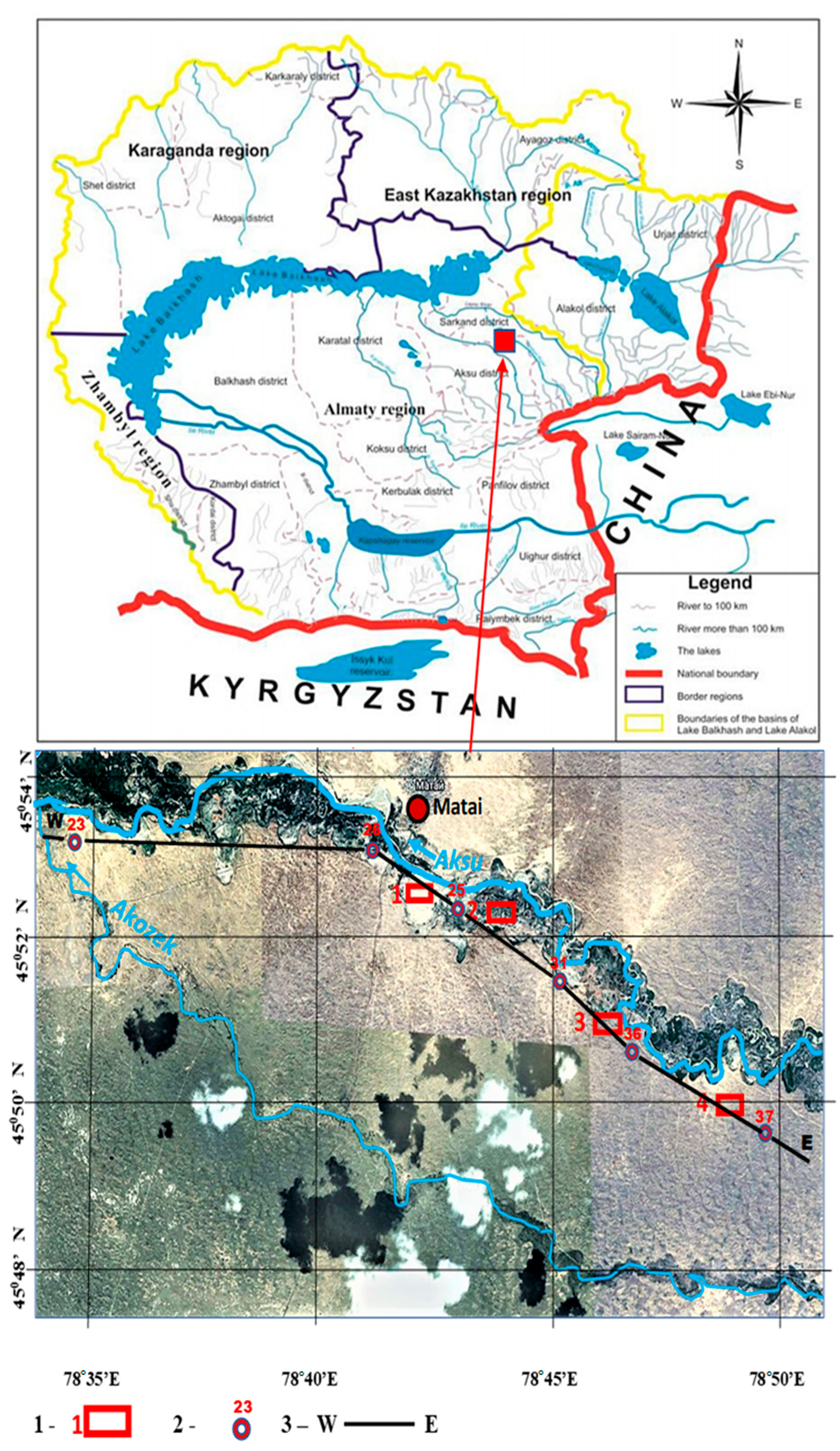

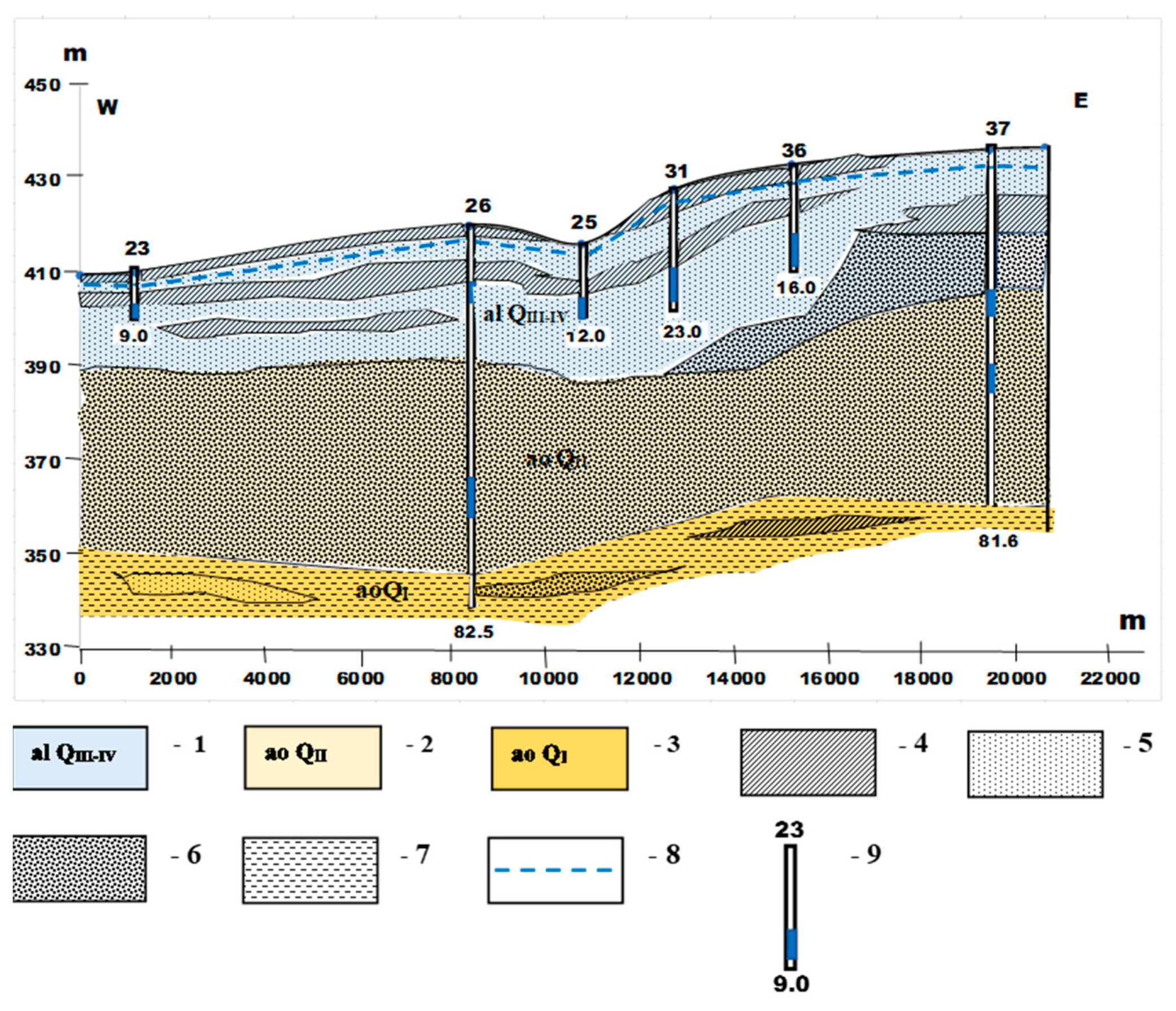
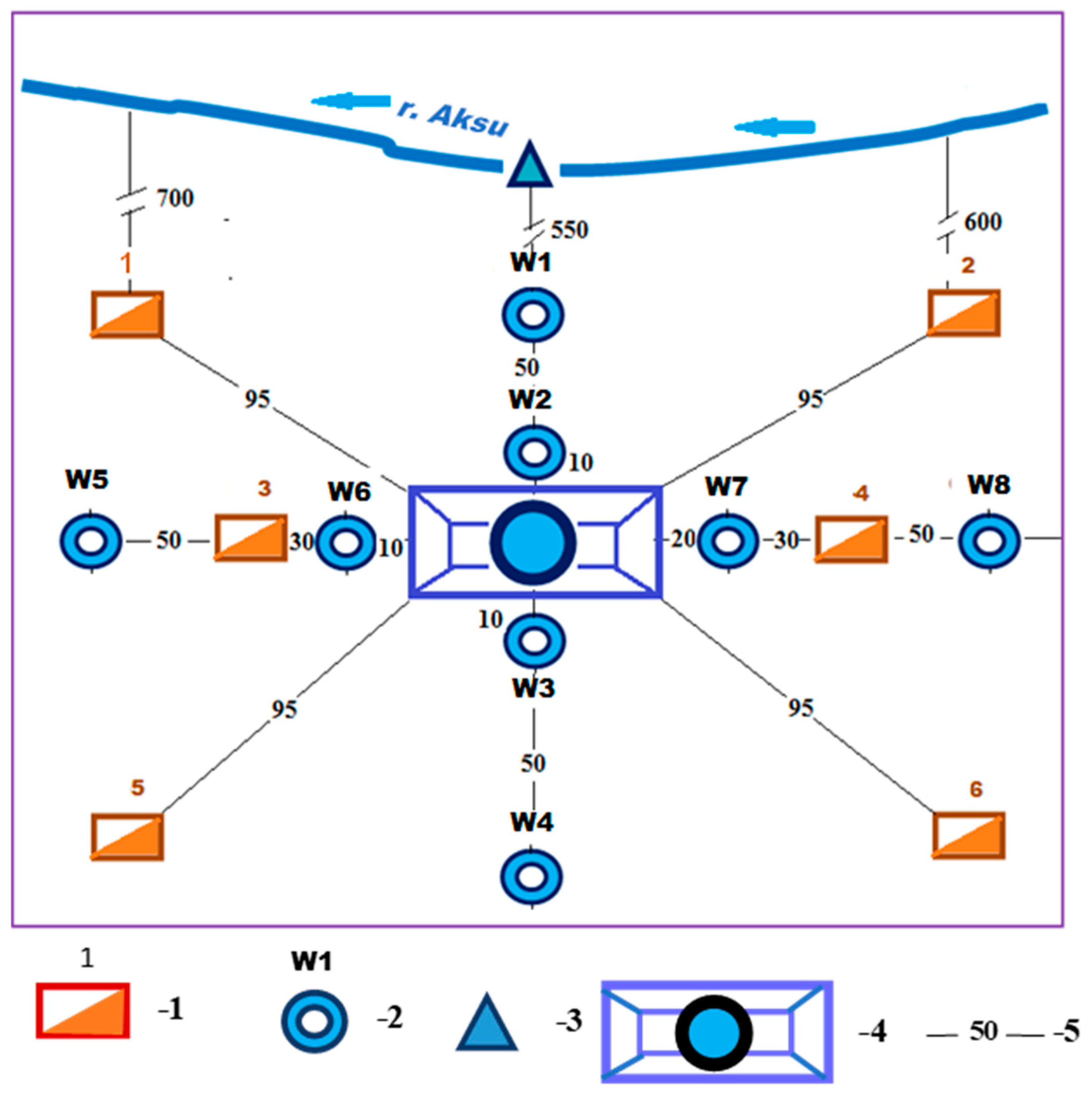



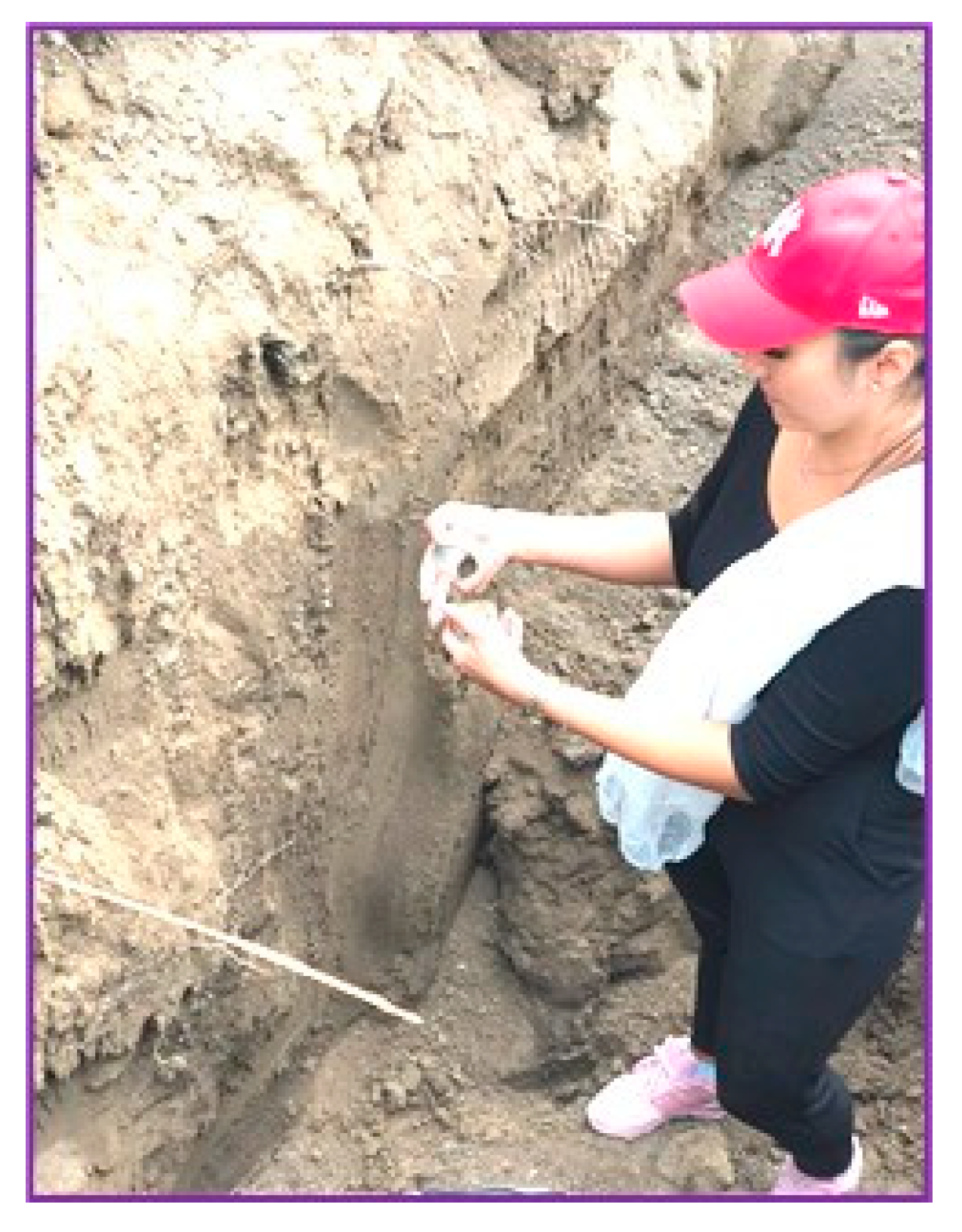


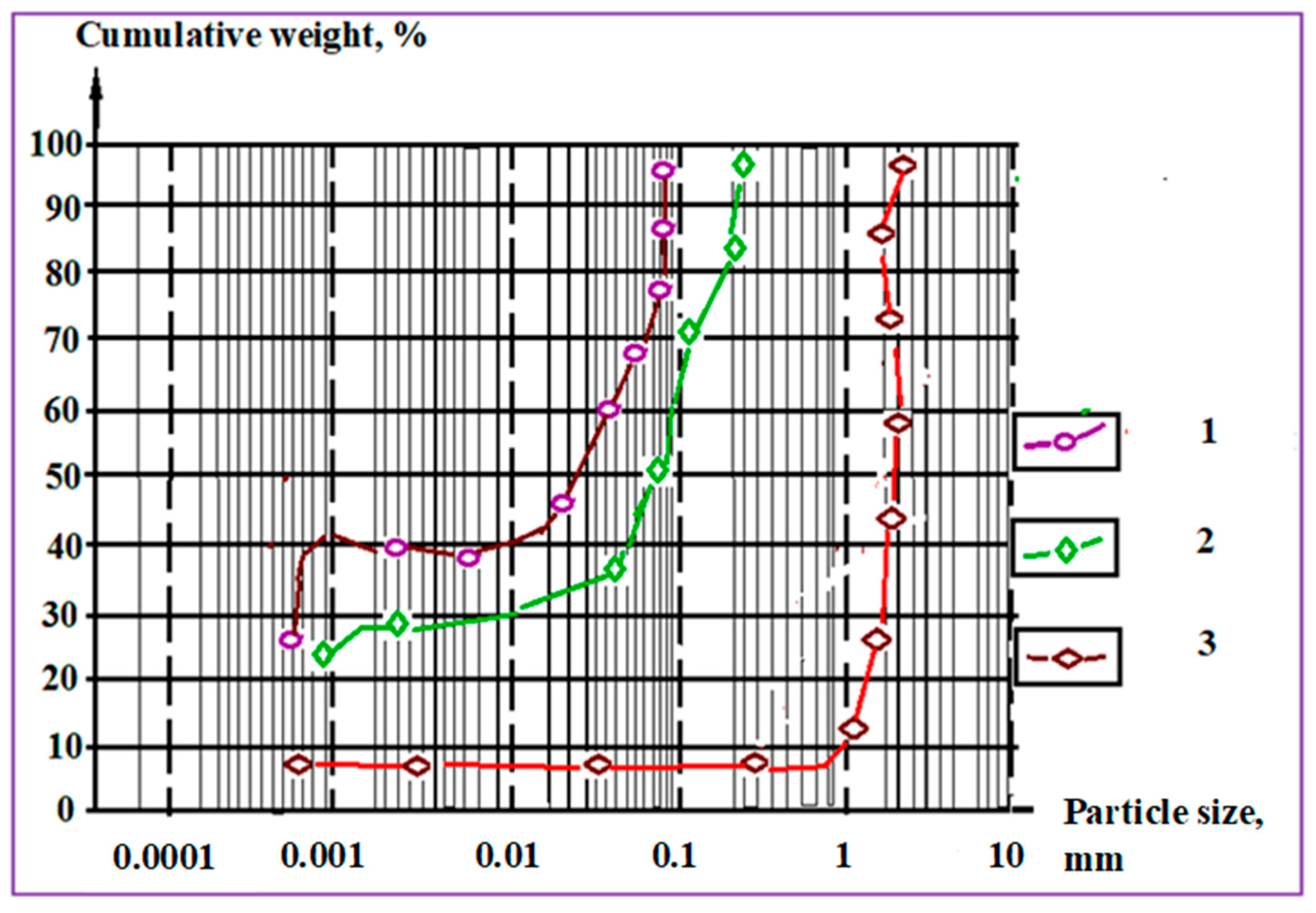







| Lithological Composition of the Soil | The Mechanical Components of the Soil, % | ||||||
|---|---|---|---|---|---|---|---|
| 7.0–5.0 | 5.0–2.0 | 2.0–1.0 | 1.0–0.5 | 0.5–0.05 | 0.05–0.005 | Less 0.005 | |
| The various grained sand, with up to 30% of fine gravel | - | 17.2 | 10.8 | 15.3 | 34.4 | 12.8 | 9.5 |
| Medium-grained sand | - | 6.8 | 31.0 | 19.5 | 36.4 | 3.1 | 3.2 |
| Fine-grained sand | - | - | - | 11.6 | 82.4 | 4.7 | 1.3 |
| The various grained sand with lenses of medium loam | - | - | 59.6 | 12.8 | 2.1 | 3.6 | 12.5 |
| Sandy loam | - | - | - | 15.5 | 35.5 | 24.8 | 24.2 |
| A loam with lenses of medium-grained sand | - | - | 9.8 | 16.5 | 9.0 | 31.2 | 42.7 |
| Medium loam | - | - | - | - | 56.0 | 32.2 | 11.8 |
| Heavy loam | - | - | - | 3.7 | 20.5 | 58.7 | 17.5 |
| Water Percolation Test Number | Soil Name and Layer Depth from the Ground Surface | Date | Measurement Number | Measurement Time, hour, min. | The Time Interval between Measurements, min | Water Percolated Volume, dm3 | Percolated Rate, dm3/min | The Calculated Value of Hydraulic Conductivity, m/day |
|---|---|---|---|---|---|---|---|---|
| 1 | 2 | 3 | 4 | 5 | 6 | 7 | 8 | 9 |
| Test No 1 | Sandy loam, 1.2 m. | 28 May 2018 | 1 | 08.00 | - | - | - | 1.10 |
| 2 | 08.05 | 5 | 1.50 | 0.30 | ||||
| 3 | 08.10 | 5 | 1.30 | 0.26 | ||||
| 4 | 08.15 | 5 | 1.10 | 0.22 | ||||
| 5 | 08.20 | 5 | 0.95 | 0.19 | ||||
| 6 | 08.30 | 10 | 1.70 | 0.17 | ||||
| 7 | 08.40 | 10 | 1.65 | 0.165 | ||||
| 8 | 08.50 | 10 | 1.55 | 0.155 | ||||
| 9 | 09.00 | 10 | 1.40 | 0.14 | ||||
| 10 | 09.12 | 12 | 1.68 | 0.14 | ||||
| 11 | 09.24 | 12 | 1.71 | 0.142 | ||||
| 12 | 09.36 | 12 | 1.68 | 0.14 | ||||
| 13 | 09.48 | 12 | 1.44 | 0.12 | ||||
| 14 | 10.00 | 12 | 1.38 | 0.115 | ||||
| 15 | 10.15 | 15 | 1.50 | 0.10 | ||||
| 16 | 10.30 | 15 | 1.20 | 0.08 | ||||
| 17 | 10.45 | 15 | 1.27 | 0.085 | ||||
| 18 | 11.00 | 15 | 1.26 | 0.084 | ||||
| 19 | 11.20 | 20 | 1.70 | 0.085 | ||||
| 20 | 11.40 | 20 | 1.64 | 0.082 | ||||
| 21 | 12.00 | 20 | 1.60 | 0.08 | ||||
| 22 | 12.30 | 30 | 1.83 | 0.061 | ||||
| 23 | 13.00 | 30 | 1.83 | 0.061 | ||||
| 24 | 14.00 | 60 | 3.60 | 0.061 | ||||
| 25 | 15.00 | 60 | 3.60 | 0.061 | ||||
| 26 | 16.00 | 60 | 3.54 | 0.059 | ||||
| 27 | 17.00 | 60 | 3.54 | 0.059 | ||||
| Test No 2, | The various grained sand, with up to 30% of fine gravel | 29 May 2018 | 1 | 08.00 | - | - | 3.13 | |
| 2 | 08.05 | 5 | 2.00 | 0.40 | ||||
| 3 | 08.10 | 5 | 1.875 | 0.375 | ||||
| 4 | 08.15 | 5 | 1.875 | 0.375 | ||||
| 5 | 08.20 | 5 | 1.875 | 0.375 | ||||
| 6 | 08.25 | 5 | 1.875 | 0.375 | ||||
| 7 | 08.30 | 5 | 1.875 | 0.375 | ||||
| 8 | 08.40 | 10 | 3.75 | 0.375 | ||||
| 9 | 08.50 | 10 | 3.65 | 0.365 | ||||
| 10 | 09.00 | 10 | 3.50 | 0.35 | ||||
| 11 | 09.10 | 10 | 3.50 | 0.35 | ||||
| 12 | 09.20 | 10 | 3.00 | 0.30 | ||||
| 13 | 09.30 | 10 | 2.50 | 0.25 | ||||
| 14 | 09.40 | 10 | 2.30 | 0.23 | ||||
| 15 | 09.50 | 10 | 2.25 | 0.225 | ||||
| 16 | 10.00 | 10 | 2.27 | 0.227 | ||||
| 17 | 10.15 | 15 | 3.37 | 0.225 | ||||
| 18 | 10.30 | 15 | 3.15 | 0.210 | ||||
| 19 | 10.45 | 15 | 2.63 | 0.175 | ||||
| 20 | 11.00 | 15 | 2.25 | 0.15 | ||||
| 21 | 11.20 | 20 | 3.00 | 0.15 | ||||
| 22 | 11.40 | 20 | 2.20 | 0.11 | ||||
| 23 | 12.00 | 20 | 1.70 | 0.085 | ||||
| 24 | 12.30 | 30 | 2.85 | 0.095 | ||||
| 25 | 13.00 | 30 | 2.70 | 0.090 | ||||
| 26 | 14.00 | 60 | 5.22 | 0.087 | ||||
| 27 | 15.00 | 60 | 5.22 | 0.087 |
| Lithological Composition of the Soil | Hydraulic Conductivity, m/day | The Difference, Abs. | Difference, % | |
|---|---|---|---|---|
| Percolated Tests | An Empirical Equation of Hazen | |||
| The various grained sand, with up to 30% of fine gravel | 3.13 | 4.50 | +1.37 | +6.9 |
| 4.32 | 5.05 | +0.73 | +8.5 | |
| Medium-grained sand | 1.49 | 1.91 | +0.42 | +7.8 |
| 1.64 | 1.95 | +0.01 | +8.4 | |
| Fine-grained sand | 1.32 | 1.36 | +0.04 | +1 |
| 1.38 | 1.35 | −0.03 | −1 | |
| The various grained sand with lenses of medium loam | 0.93 | 0.94 | +0.01 | +0.8 |
| Sandy loam | 1.10 | 1.12 | +0.02 | +1 |
| 1.18 | 1.18 | 0 | 0 | |
| A loam with lenses of medium-grained sand | 0.79 | 0.81 | +0.02 | +1 |
| Medium loam | 0.71 | 0.73 | +0.02 | +1 |
| Heavy loam | 0.11 | 0.12 | +0.01 | +1 |
| Date | W1 | W2 | W3 | W4 | W5 | W8 |
|---|---|---|---|---|---|---|
| 1 March 2017 | HCO3 68 SO4 23 CI 9 Ca 38 Na 32 Mg 30 | HCO3 81 SO4 13 CI 6 Mg 48 Na 30 Ca 22 | HCO3 75 SO4 21 CI 4 Mg 39 Na 37 Ca 24 | SO4 61 HCO3 33 CI 6 Na 68 Mg 19 Ca 13 | HCO3 50 SO4 32 CI 18 Na 50 Mg 31 Ca 19 | HCO3 79 SO4 12 CI 9 Na 84 Ca 13 Mg 3 |
| 12 June 2017 | HCO3 54 SO4 35 CI 11 Na 50 Mg 29 Ca 21 | HCO3 54 SO4 35 CI 11 Na 50 Mg 29 Ca 21 | HCO3 84 SO4 10 CI 6 Mg 45 Na 32 Ca 23 | SO4 57 HCO3 32 CI 11 Na 53 Ca 29 Mg 18 | SO4 78 HCO3 17 CI 5 Na 62 Mg 31 Ca 7 | HCO3 68 SO4 21 CI 11 Na 88 Ca 10 Mg 2 |
| 18 August 2017 | HCO3 67 SO4 23 CI 10 Na 44 Mg 35 Ca 21 | HCO3 75 SO4 18 CI 7 Mg 43 Na 38 Ca 19 | HCO3 69 SO4 16 CI 15 Na 46 Mg 38 Ca16 | SO4 52 HCO3 32 CI 6 Mg 46 Na 40 Ca 14 | SO4 68 HCO3 23 CI 9 Na 38 Ca 33 Mg 29 | HCO3 57 SO4 25 CI 9 Na 49 Ca 28 Mg 23 |
| 30 September 2017 | HCO3 68 SO4 24 CI 8 Na 56 Mg 26 Ca 18 | HCO3 68 SO4 25 CI 7 Na 43 Mg 30 Ca 27 | SO4 58 HCO3 37 CI 5 Na 73 Mg 15 Ca 12 | HCO3 57 SO4 35 CI 8 Na 50 Ca 41 Mg 9 | HCO3 76 SO4 16 CI 8 Na 69 Ca 17 Mg 14 | HCO3 80 SO4 16 CI 4 Na 38 Mg 31 Ca 31 |
| Number of the Mini Pool | Sediment’s Name | Effective Diameter of Mechanical Particles in the Sludge, mm | Size of Fractions, mm | Total Particle Size | |||||
|---|---|---|---|---|---|---|---|---|---|
| 0.25–0.05 | 0.05–0.01 | 0.01–0.005 | 0.005–0.001 | Less 0.001 | Less 0.01 | More 0.01 | |||
| 1 | muddy clay | 0.001–0.0005 | 14.2 | 23.6 | 6.8 | 24.65 | 30.75 | 37.8 | 62.2 |
| 2 | muddy clay | 0.001–0.0005 | 15.15 | 20.46 | 9.1 | 26.13 | 29.16 | 35.61 | 64.39 |
| 3 | clayey silt | 0.001–0.0005 | 7.3 | 16.4 | 10.2 | 19.6 | 46.5 | 23.7 | 76.3 |
| 4 | muddy clay | 0.001–0.0005 | 11.44 | 22.15 | 8.65 | 29.6 | 28.16 | 33.59 | 66.41 |
| Number of the Mini Pool | Sediment’s Name | Dirt Holding Capacity, kg/m2 | The Duration of Deep Clogging, Day | The Clogging Layer Thickness, mm | |||
|---|---|---|---|---|---|---|---|
| Measured | Calculated | Difference (calc.-meas.) | A Correlation Coefficient | ||||
| 1 | muddy clay | 5.25 | 114 | 4.04 | 5.3 | 1.26 | 0.76 |
| 2 | muddy clay | 3.92 | 98 | 6 | 4.9 | −1.1 | 0.82 |
| 3 | clayey silt | 3.83 | 168 | 3 | 2.7 | −0.3 | 0.90 |
| 4 | muddy clay | 3.72 | 155 | 5 | 5.3 | 0.3 | 0.90 |
Publisher’s Note: MDPI stays neutral with regard to jurisdictional claims in published maps and institutional affiliations. |
© 2022 by the authors. Licensee MDPI, Basel, Switzerland. This article is an open access article distributed under the terms and conditions of the Creative Commons Attribution (CC BY) license (https://creativecommons.org/licenses/by/4.0/).
Share and Cite
Mirlas, V.; Kulagin, V.; Ismagulova, A.; Anker, Y. Field Experimental Study on the Infiltration and Clogging Processes at Aksu Research Site, Kazakhstan. Sustainability 2022, 14, 15645. https://doi.org/10.3390/su142315645
Mirlas V, Kulagin V, Ismagulova A, Anker Y. Field Experimental Study on the Infiltration and Clogging Processes at Aksu Research Site, Kazakhstan. Sustainability. 2022; 14(23):15645. https://doi.org/10.3390/su142315645
Chicago/Turabian StyleMirlas, Vladimir, Vitaly Kulagin, Aida Ismagulova, and Yaakov Anker. 2022. "Field Experimental Study on the Infiltration and Clogging Processes at Aksu Research Site, Kazakhstan" Sustainability 14, no. 23: 15645. https://doi.org/10.3390/su142315645
APA StyleMirlas, V., Kulagin, V., Ismagulova, A., & Anker, Y. (2022). Field Experimental Study on the Infiltration and Clogging Processes at Aksu Research Site, Kazakhstan. Sustainability, 14(23), 15645. https://doi.org/10.3390/su142315645







